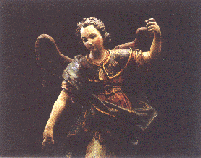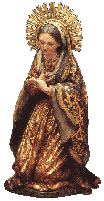 CULPTURE
CULPTURE  |
This gallery displays a collection of figures produced in New Spain during the 16th, 17th and 18th centuries. Most of these works date from the peak of the baroque, at a time when sculpture had reached its height of perfection. Sculpture, like painting, was closely bound to the propagation of the faith. Full figure and bas-relief images of all its dignitaries flooded the churches as part of altar pieces and displays with a strict evangelical purpose. |
The collection displays a large group of estofado sculptures, a technique which gave colonial art a unique touch. It consists of painting a previously gilded wooden sculpture in polychrome, then etching the colored layers with a scriber to allow the gilt to show through and achieve the effect of gold-embroidered fabric. Particularly delicate figures were produced in Guatemala where a school flourished, satisfying the demands which reached the farthest corners of the Spanish empire. Their quality is embodied in a group of figures depicting the Virgin Mary, Mary Magdalene and St. John, as well as a Virgin Dolorosa which time has not impaired.
 |
Another interesting technique in colonial
sculpture displayed in the collection is one that used a
paste mada of ground sugarcane to which a natural
agglutinate was added. The technique of sugarcane-paste
sculpture was known to the Indian before the arrival of
the Spaniards. Its later use was due (among other
reasons) to the light weight of resulting figures, which
made them quite portable and ideal for religious
processions. Examples of the technique are a figure of
Christ recumbent in the arms of the Father and of St.
Michael the Archangel who (though lacking wings), is
still very much a celestial warrior. The gallery includes
samples of European sculpture, the majority of which are
German and Flemish bas-reliefs from the 15th and 16th
centuries.
Late Gothic and early central European renaissance styles are featured among the gallery's religious figures. |
There are numerous representations of Christ's Passion which in all probability come from groups of figures composing the Stations of the Cross, although there are also scenes from the life of the Virgin Mary and Biblical scenes in general.




©Todos los derechos reservados, se prohibe la
reproducción salvo permiso por escrito del autor.
©All rigths reserved, material duplication is prohibited
without written authorization by its author.